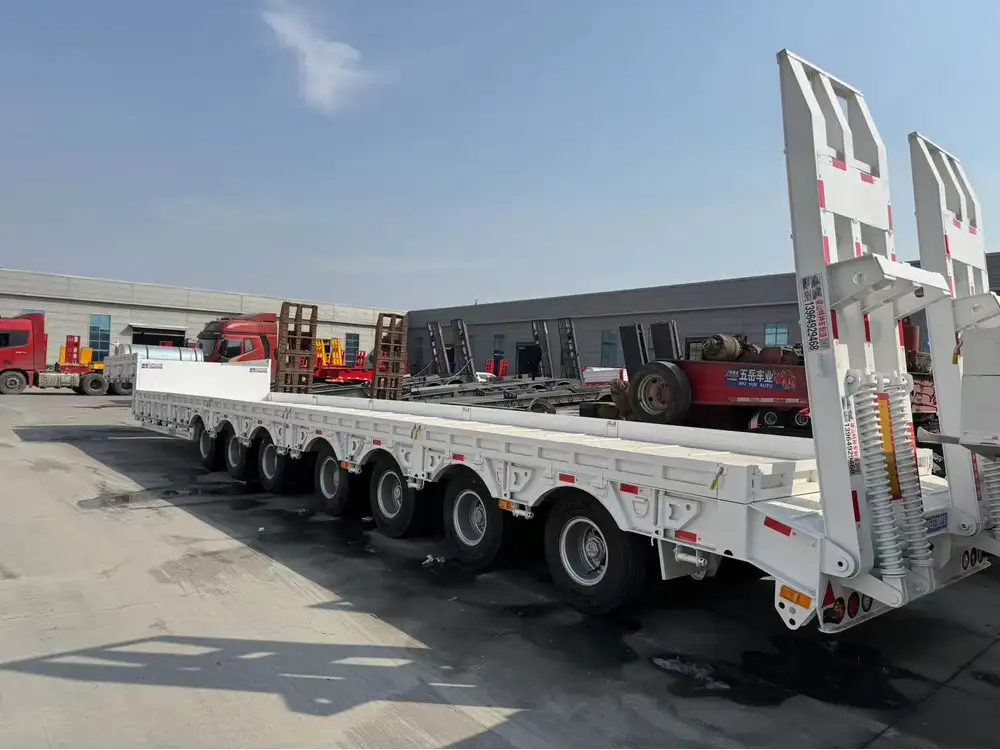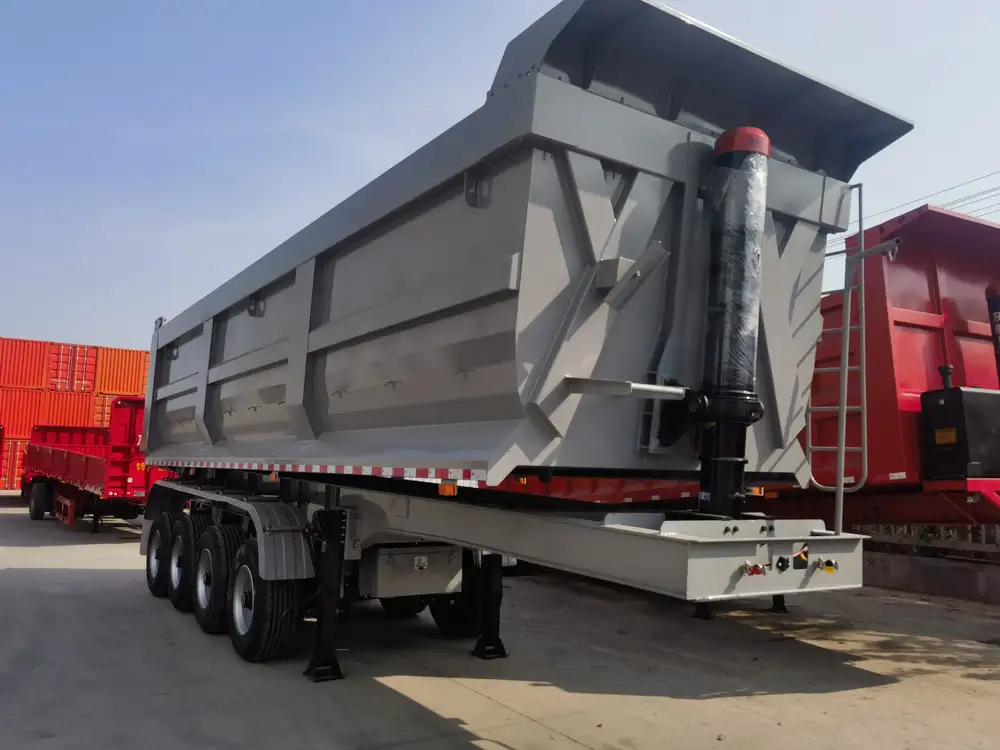When it comes to choosing the right semi-trailer for your hauling needs, understanding the specifications is crucial. Among the many types of trailers available, end dump trailers stand out for their versatility and efficacy in transporting bulk materials—from sand to gravel to asphalt. One of the most frequently asked questions revolves around their dimensions, particularly “how long is an end dump trailer?” This article aims to dissect the various lengths of end dump trailers, their features, and factors influencing their dimensions.
What is an End Dump Trailer?
Before delving into the specifics of length, it’s essential to understand what an end dump trailer is. An end dump trailer consists of a truck chassis and a trailer that tilts to allow direct unloading of its contents. This tilting feature provides significant efficiency, particularly in construction and waste management industries.
Key Features of End Dump Trailers
- Unloading Mechanism: The trailer frame can pivot, allowing loads to be dumped directly from the rear.
- Variety of Sizes: Designed with different lengths and configurations to accommodate varying types of cargo.
- Material Construction: Commonly made from steel or aluminum, impacting overall weight and durability.
All these elements contribute not only to their functionality but also to the dimensions that must be considered when selecting an end dump trailer.

Standard Lengths of End Dump Trailers
The length of an end dump trailer can significantly vary based on the manufacturer and the intended use. Typically, they range from 20 to 40 feet. Below is a table summarizing the standard lengths and common uses:
| Trailer Length (ft) | Common Uses | Weight Capacity (lbs) | Notes |
|---|---|---|---|
| 20 | Small loads | Up to 15,000 | Suitable for landscaping and small construction jobs. |
| 30 | General construction | 15,000 – 25,000 | Popular for hauling dirt and gravel. |
| 34 | Aggregate hauling | 25,000 – 35,000 | Most commonly used for large construction sites. |
| 40 | Heavy-duty applications | Up to 50,000 | Frequently used in mining and large scale operations. |
In addition, manufacturers may also produce custom lengths to meet specific industry needs, ranging from compact sizes to extended versions for increased capacity.
Factors Influencing the Length of End Dump Trailers
Several factors come into play when discussing the length of end dump trailers. These factors can dictate not just the physical dimensions but also weight limits, maneuverability, and cargo types.
1. Material Type
The material used in the construction of the trailer plays an influential role in determining its length. For instance:
- Steel trailers tend to be heavier and thus may be found in shorter configurations to maintain legal weight limits.
- Aluminum offers a lightweight alternative, allowing for longer trailer designs without excessive weight.

2. Purpose and Load Type
The intended purpose greatly affects the length:
- Construction sites may prefer longer trailers for bulk materials.
- Landscaping businesses often opt for shorter models for easy handling.
3. Weight Regulations
Each state in the United States has specific weight regulations that influence trailer design and length. For example, the federal law limits the gross vehicle weight to 80,000 pounds on interstate highways, necessitating careful planning about trailer length and design to remain compliant.
4. Towing Vehicle Capacity
The towing capacity of your truck is critical.
- Using a truck designed to pull longer trailers ensures not only safety but also compliance with legal standards.
- It’s important to pair a trailer length that aligns with the vehicle’s Gross Vehicle Weight Rating (GVWR).

Advantages and Disadvantages of Different Trailer Lengths
To better understand the implications of trailer length, below is a structured comparison highlighting the benefits and drawbacks of varying sizes of end dump trailers:
Shorter Trailers (20 – 30 feet)
Advantages:
- Maneuverability: Easier to navigate tight job sites.
- Weight: Generally lighter, which can facilitate easier towing and increase the permitted load on the haul truck.

Disadvantages:
- Capacity: Limited volume for large loads can mean more trips for similar quantities.
- Profitability: May result in higher operational costs to transport the same volume.
Longer Trailers (34 – 40 feet)
Advantages:
- Load Capacity: Capable of carrying more for fewer trips, enhancing efficiency.
- Stability: Longer trailers often provide better stability during transport.

Disadvantages:
- Maneuverability: Can be challenging to navigate through tight spaces.
- Cost: Potentially higher initial costs due to more heavy-duty components.
Maintenance Considerations for End Dump Trailers
Understanding the length of end dump trailers should also encompass the maintenance aspect:
1. Regular Inspections
Regular inspection of the trailer’s hydraulic system is essential, especially for longer trailers that endure substantial forces during unloading.

2. Tire Maintenance
The longer the trailer, the more tires are involved in supporting the load, which emphasizes the need for routine tire maintenance to prevent blowouts—critical for safety on the road.
3. Frame Integrity
The integrity of the trailer frame is paramount. Longer trailers may experience more flex and stress, making regular checks for corrosion or frame damage essential.
Choosing the Right End Dump Trailer Length
Ultimately, selecting the right end dump trailer length involves a careful assessment of your unique needs. Consider the following steps:

Step 1: Assess Your Cargo
- What materials will you be transporting?
- Understanding the type of materials defines the ideal trailer length.
Step 2: Evaluate Your Transport Conditions
- Are you often working in urban environments or rural areas?
- Maneuverability can be a decisive factor depending on your typical job site.
Step 3: Match Your Towing Vehicle
- Ensure your towing vehicle can handle the dimensions of the trailer effectively without exceeding legal limits.

Step 4: Regulatory Compliance
- Verify your chosen trailer’s specifications are compliant with local, state, and federal regulations to avoid potential fines or safety issues.
Conclusion: Making the Right Choice for Your Needs
In conclusion, end dump trailers are versatile, efficient, and crucial for various industries. Knowing the answer to “How long is an end dump trailer?” goes beyond just numbers—it involves understanding the implications of different lengths on functionality, operational efficiency, and regulatory compliance.
By carefully considering your cargo, work environment, vehicle capacity, and regulatory requirements, you can make an informed decision that aligns with your needs. Whether opting for a compact model to navigate tight job sites or selecting a longer version to maximize load capacity, the right end dump trailer can streamline operations and improve productivity in your business.
Choose wisely, and let the specifications guide your procurement strategy to ensure a sound investment in your transportation capabilities.



